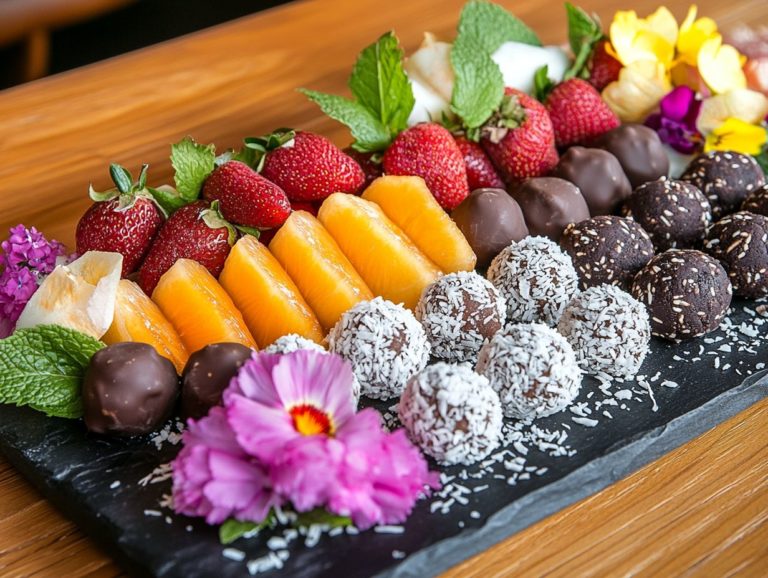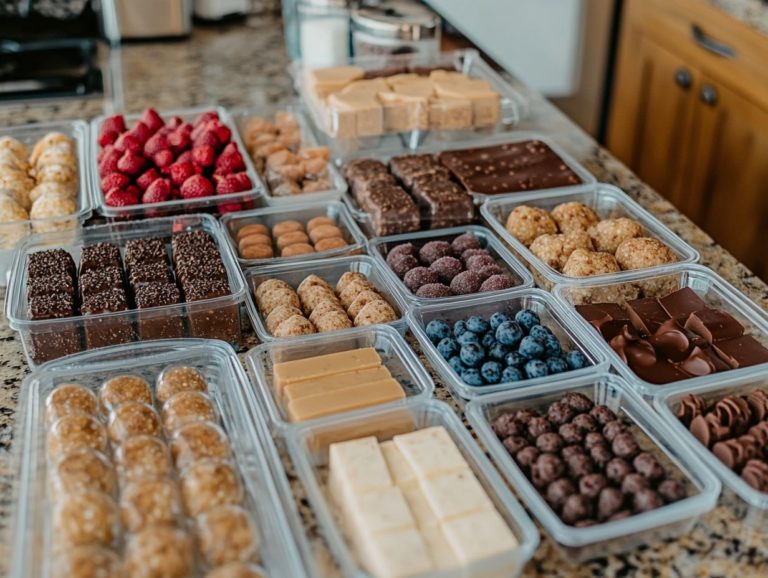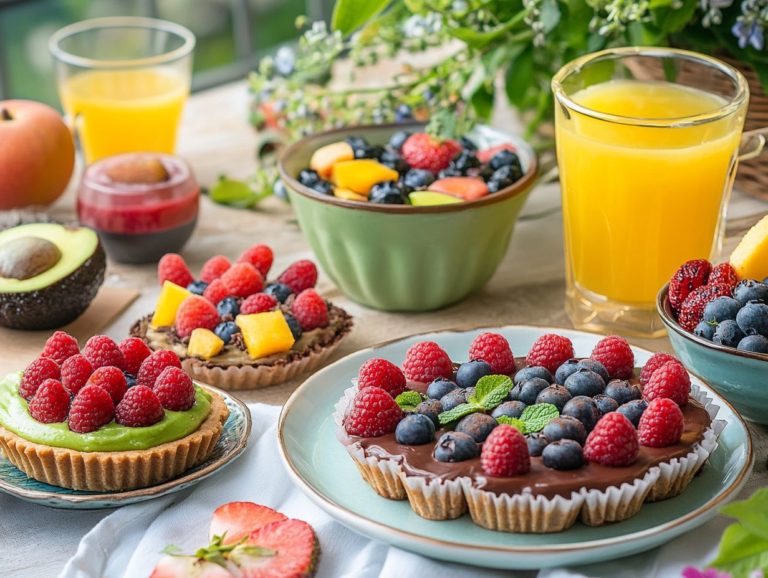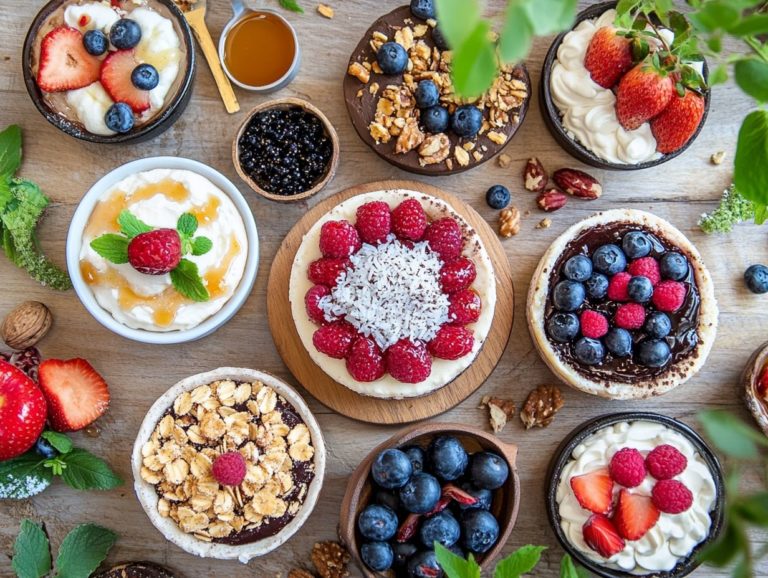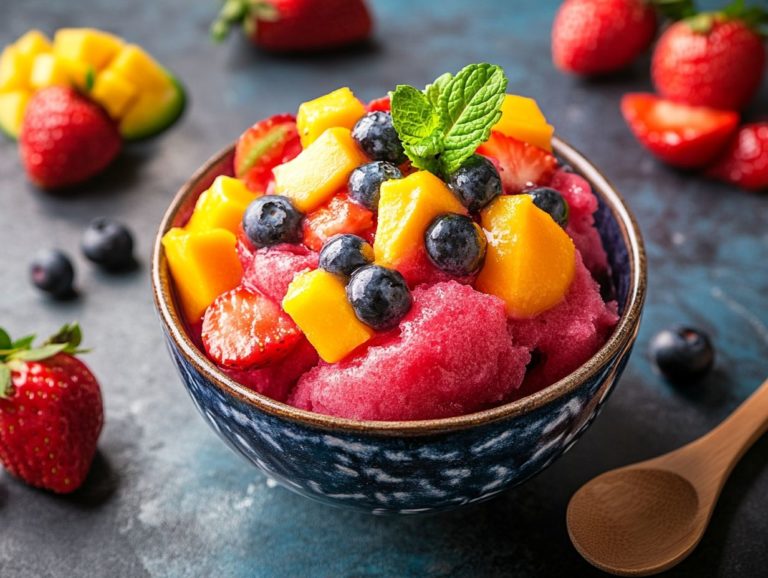Understanding the Texture of Raw Desserts
Raw desserts present a delightful and nutritious twist on traditional sweets, inviting you to experience a spectrum of flavors and textures without the necessity of baking. Experience the joy of raw desserts now! These raw delights often feature fresh fruits and sugar alternatives, making them a healthier alternative to conventional cakes.
Crafted from wholesome ingredients, these treats not only satisfy your sweet cravings but also offer a wealth of nutritious benefits. Uncover what sets raw desserts apart, delve into their essential ingredients including superfoods and healthy fats, and learn how they achieve their distinctive textures.
Explore the diverse types of raw desserts available, including raw cakes, raw brownies, and raw ice creams. Discover practical storage tips and safety considerations, ensuring you can effortlessly indulge in these delectable creations within the comfort of your home.
Contents
- Key Takeaways:
- What Are Raw Desserts?
- What Are the Main Ingredients in Raw Desserts?
- What Is the Texture of Raw Desserts?
- What Are the Different Types of Raw Desserts?
- How Do You Store Raw Desserts?
- Are There Any Safety Concerns with Raw Desserts?
- Frequently Asked Questions
- What is the texture of raw desserts, including raw carrot cake?
- How do raw desserts get their unique texture, like in a vanilla gelato?
- Can raw desserts be crunchy, like pralines?
- Why is it important to understand the texture of raw desserts, including soft desserts?
- How can you adjust the texture of a raw dessert, particularly the tasty layers?
- What are some common texture variations in raw desserts, such as in a chocolate cheesecake?
Key Takeaways:
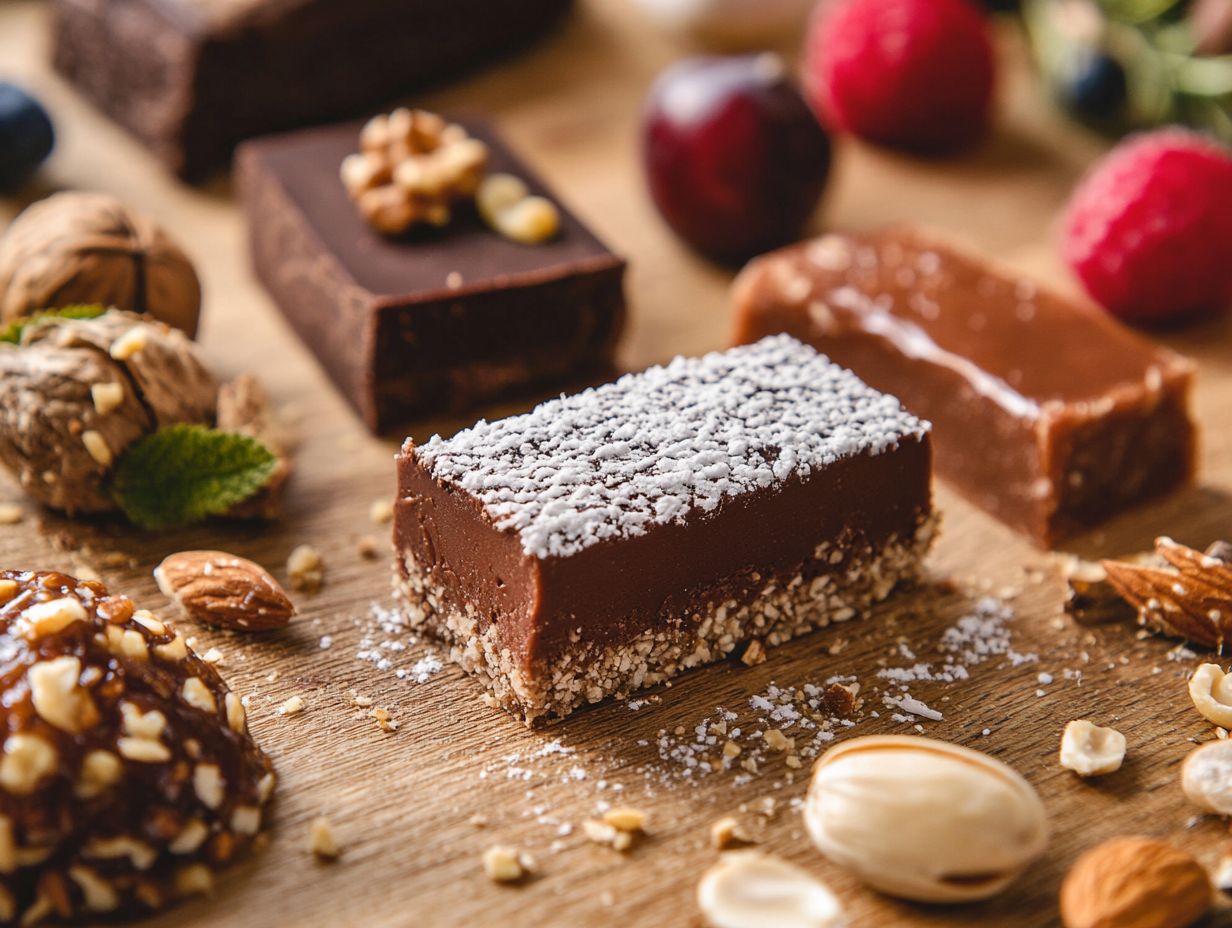
What Are Raw Desserts?
Raw desserts, featuring raw cakes and other inventive creations, present a healthier alternative to traditional cakes, delivering a delightful blend of flavor and nutrition that resonates with your mindful dietary choices. You might even find nut-free raw cakes and oil-free jar cakes among the array of options.
These desserts are crafted from high-quality ingredients like nuts, healthy fats, and superfoods. This ensures they are not only rich in nutritional benefits but also visually stunning. The moist, sticky texture will satisfy your cravings, making them hard to resist. They often feature natural colors and special toppings that enhance their appeal.
As highlighted in Nazl Develi’s ‘Gourmet Raw Cakebook’, raw desserts burst with natural flavors and vibrant colors. This makes them a popular choice for an exquisite dining experience at Studio Aurora or a delightful treat in the comfort of your home. The ‘Gourmet Raw Cakebook’ also provides valuable kitchen tips and successful experience stories to inspire your creations.
What Are the Benefits of Eating Raw Desserts?
Raw desserts can be visually appealing and often feature special ingredients that enhance their nutritional value. Eating raw desserts offers a wealth of nutritious benefits, transforming them into an exciting and healthier alternative to traditional sweets.
Choose gluten-free recipes to indulge in exciting, innovative treats that delight your taste buds. These often feature special ingredients like superfoods, healthy fats, and natural sweeteners. These additions not only enhance your overall well-being but also satisfy your sweet cravings without the guilt.
Beyond being a delightful indulgence, raw desserts support improved digestion. This is thanks to their reliance on raw fruits, nuts, and seeds, all of which are packed with enzymes and fiber. You may also find that your energy levels increase after enjoying these wholesome delights, a perk linked to their low glycemic index and nutritional value, which help keep your blood sugar levels stable. These nutritious benefits are perfect for health-conscious dessert lovers.
By choosing whole foods over processed ingredients, these desserts deliver essential vitamins and minerals that strengthen your immune function. This makes them an ideal option for health-conscious dessert lovers like you, who seek both nourishment and satisfaction in every bite.
What Are the Main Ingredients in Raw Desserts?
The main ingredients in raw desserts are an exquisite selection of natural and whole foods that offer essential nutrients and vibrant flavors, all while preserving their unprocessed integrity. These ingredients support a flavor balance that makes each dessert unique.
You ll find that staples like nuts, coconut oil, and healthy fats create a rich foundation. To elevate the experience, sugar alternatives and unique additions such as superfoods and seasonal fruits enhance both taste and nutritional value.
This opens the door to delightful creations like raw cakes, raw tiramisu, and brownies, inviting a world of culinary creativity and innovative recipes.
Common Substitutions for Traditional Baking Ingredients
When you embark on the journey to raw desserts, understanding some common substitutions for traditional baking ingredients is crucial. These alternatives not only offer healthier options but do so without compromising on flavor or texture.
For example, consider using sugar alternatives like dates or maple syrup to sweeten your raw cakes. By incorporating healthy fats such as coconut oil or nut butters, you ll enhance the creaminess and moisture of these naturally gluten-free creations, making them just as satisfying as their baked counterparts.
Choosing almond or oat flour in place of regular wheat flour caters to those with gluten sensitivities and introduces a delightful nutty flavor to your recipes. Opting for raw cacao instead of cocoa powder can elevate the richness of your desserts while maintaining the integrity of the ingredients.
Chia seeds or flaxseeds can serve as superb egg replacements, binding your mixtures together beautifully. For those who follow a vegan lifestyle, these substitutions are crucial for creating raw vegan desserts.
These thoughtful adjustments preserve the essence of classic baked goods and unveil a treasure trove of nutritional benefits, catering to the tastes of health-conscious dessert enthusiasts.
What Is the Texture of Raw Desserts?
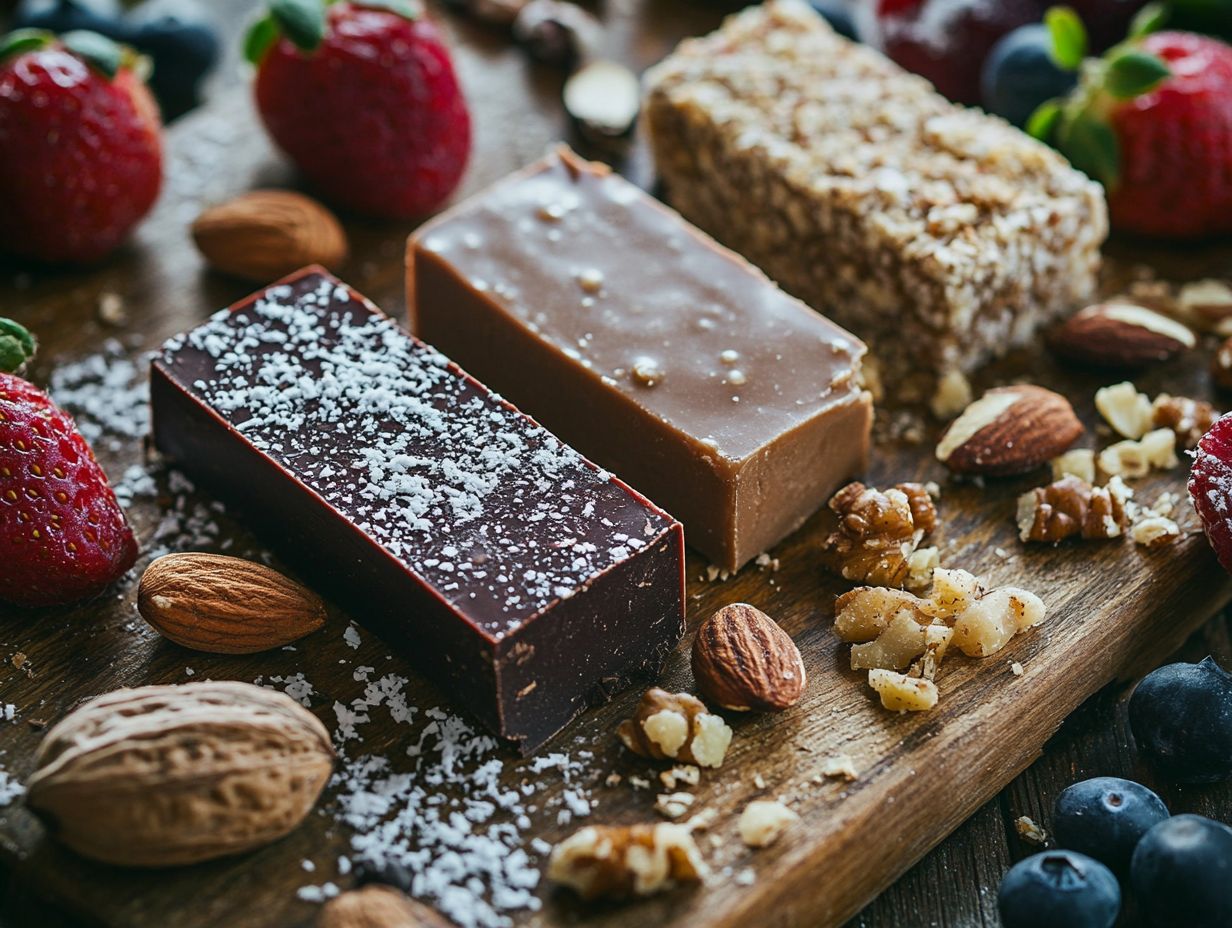
Texture notes are essential for understanding how to achieve the desired mouthfeel in these desserts.
The texture of raw desserts is a defining feature that distinguishes them from traditional baked goods. You ll often find a delightful moist and sticky quality that feels both satisfying and indulgent.
By incorporating ingredients such as nuts and healthy fats, raw desserts can achieve that luxurious creamy consistency found in treats like raw cheesecake or brownies. They also offer chewy textures that appeal to a variety of preferences, making them more appealing to a broader audience.
How Is Texture Achieved Without Baking?
Texture in raw desserts is achieved without the need for baking, relying on a harmonious blend of techniques such as blending, resting, and occasionally dehydrating. By utilizing a high-speed blender, you can create a smooth and creamy base for your raw cakes and other decadent treats.
Incorporating dehydration can introduce delightful chewy textures, elevating your plating to a visually stunning experience. Special toppings and edible decorations can further enhance the presentation.
To enhance the mouthfeel of your creations, soaking ingredients like nuts and dried fruits not only softens them but also allows their natural flavors to meld beautifully. This process contributes to a rich, decadent experience that is both indulgent and nourishing.
Each method you employ plays a crucial role: blending ensures a uniform consistency, soaking infuses moisture, and dehydrating adds that satisfying crunch. The thoughtful combination of these techniques leads to a multi-layered dessert that delights the palate and captivates the eye, transforming each bite into a true treat for the senses.
Get ready to indulge in the delightful world of raw desserts! Try making your own creations and share them with your community.
What Are Some Common Textures in Raw Desserts?
Common textures in raw desserts offer an enticing range, from moist and sticky sensations to creamy and crunchy elements, each delivering a unique experience with every bite. Imagine indulging in chewy components and crispy textures, all found in delightful treats like raw brownies or nut-free jar cakes. This contrast adds an exciting layer to the overall dessert experience. The use of fresh fruits and special ingredients ensures that the textures are both enjoyable and nutritious.
These diverse textures actively engage your senses, elevating the enjoyment of each creation. Consider the velvety smoothness of cashew cream in raw cheesecakes, perfectly complementing the delightful crunch of a granola layer or the satisfying crispiness of cacao nibs. Meanwhile, the luscious creaminess of avocado-based puddings invites you to explore an unexpected mouthfeel, enhancing the pleasure of every spoonful.
When these textures unite, they not only create a visually stunning presentation but also establish a satisfying interplay that captivates your taste buds. Each raw dessert becomes a captivating journey, ensuring that anyone fortunate enough to indulge will be thoroughly enchanted.
What Are the Different Types of Raw Desserts?
The world of raw desserts is both vast and diverse, inviting you to explore an array of delightful options, including raw cakes, raw cookies, raw ice creams, and raw chocolates. For an added touch, consider incorporating Nordic delights or seasonal cuisine into your recipes.
Each category offers innovative recipes that embody a dedication to both health and flavor, expertly using fresh ingredients and techniques that maintain their nutritional integrity while delivering extraordinary taste experiences.
1. Raw Cakes and Pies
Raw cakes and pies stand out as some of the most celebrated raw desserts, captivating you with their visually stunning designs and rich flavors, often elevated by exquisite ingredients like fresh fruits and nuts. In Nazl Develi’s ‘Gourmet Raw Cakebook’, you’ll find recipes that showcase the beauty and taste of these raw delights, making them a go-to choice for health-conscious dessert enthusiasts like yourself. Stella Nilsson’s plating presentation tips from April 2022 can further enhance your dessert creations.
These desserts typically shun traditional baking methods, relying instead on the natural sweetness of ingredients such as dates and maple syrup. With flavor profiles ranging from decadent chocolate to refreshing citrus, each bite becomes a tempting treat suitable for any occasion. The use of sugar alternatives ensures that these treats remain guilt-free.
The inclusion of vibrant superfoods, such as spirulina or matcha, not only enhances their visual appeal but also packs in a nutritional punch. With thoughtful presentation techniques, like layering colorful fruit toppings or adorning your creations with edible flowers, raw cakes and pies transform into stunning centerpieces, ensuring they are as delightful to behold as they are to savor. For instance, a well-crafted crumb coat followed by a finishing coat can elevate your raw carrot cake to new heights.
2. Raw Cookies and Bars
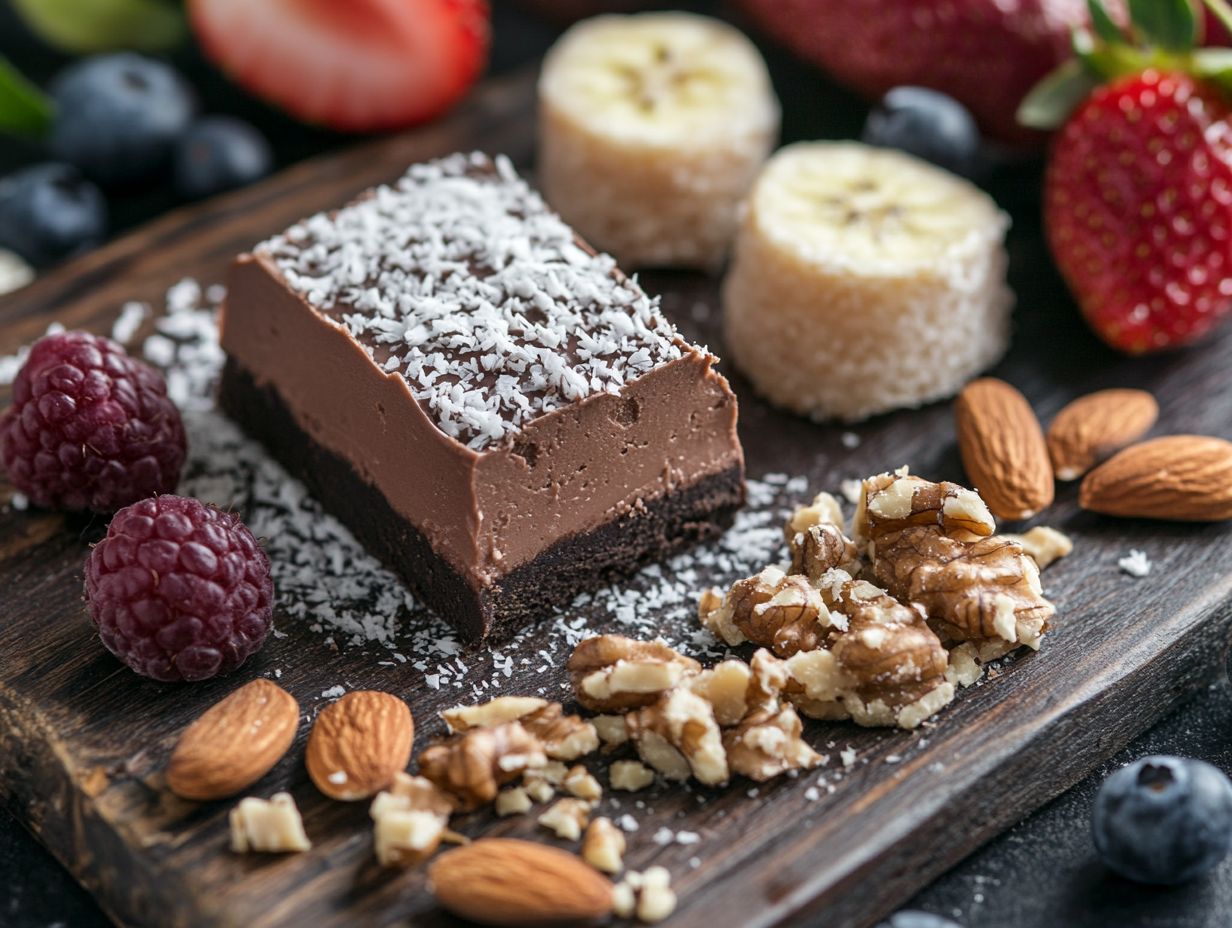
Raw cookies and bars present a delightful treat, merging the richness of natural ingredients with a satisfying chewiness that you ll find irresistible. By incorporating superfoods and other healthful components, these raw snacks strike the perfect flavor balance, catering to everyone from health lovers to dessert fans.
You can also craft these treats into chewy options if you enjoy a bit of bite.
What makes these delights truly special is their versatility; you can easily customize them to fit a wide range of tastes and dietary preferences. With a solid foundation of common ingredients like oats, nuts, seeds, and a variety of fruits, the possibilities for flavor combinations are endless. Can you imagine the bliss of chocolate and almond or the tropical sweetness of coconut and date? Each bite is a tempting experience for your taste buds. Don’t miss out on the endless flavor combinations you can create today! This versatility is highlighted in cookbooks like the Gourmet Raw Cakebook by Stella Nilsson, published in April 2022.
The textures are equally enticing, offering everything from crunchy to fudgy, making these treats a go-to choice for anyone on the move or those looking to indulge without the guilt. Whether you savor them as a breakfast alternative or a post-workout energy boost, raw cookies and bars resonate with both the health-conscious and the flavor adventurers among us. The incorporation of chewy candles adds another layer of fun and delight to these already versatile treats.
3. Raw Ice Cream and Sorbets
Raw ice creams and sorbets present a luxurious alternative to traditional frozen desserts, often crafted from fresh fruits and wholesome fats like coconut oil, expertly designed to preserve all those natural, vibrant flavors. You can easily adapt these frozen delights to reflect the seasonal cuisine, creating a refreshing treat that is both satisfying and guilt-free. For instance, a raw chocolate cheesecake can be a delightful addition to your dessert repertoire.
Imagine indulging in vibrant seasonal fruits such as ripe mangoes, juicy strawberries, or zesty lemons; each dessert truly shines with these flavors. The technique typically involves blending frozen fruits with a hint of sweetener, perhaps agave or maple syrup, and a splash of vanilla for added depth. A touch of vanilla gelato can elevate these frozen treats to gourmet levels.
Feel free to get creative by combining different fruits for unexpected flavor experiences think tart cherries paired with rich chocolate or zesty oranges mingling with smooth avocado. This innovative approach to crafting raw ice creams and sorbets not only emphasizes health but also elevates simple ingredients into gourmet treats that will undoubtedly tantalize your palate.
4. Raw Chocolates and Truffles
Raw chocolates and truffles are exquisite treats that allow you to explore innovative recipes and delightful flavor profiles, often adorned with edible decorations and special toppings that exude luxury. These decadent creations can also feature an array of fillings and pralines, making them the perfect choice for any celebration or indulgence. Incorporating soft desserts like these can truly make any event memorable.
Crafted from premium cacao, raw chocolates preserve their natural flavors, inviting endless creativity in your ingredient combinations. By employing techniques like shaping and preparing, artisans create unique shapes and textures that elevate their presentation. The allure of these confections lies not only in their rich taste but also in their ability to enhance the atmosphere of events, from birthdays to weddings.
Incorporating organic or superfood ingredients not only amplifies health benefits but also aligns perfectly with the growing trend of mindful eating. Whether elegantly displayed in luxurious boxes or artfully arranged on dessert trays, these treats are sure to leave a lasting impression on all who experience them. Nazl Develi of Studio Aurora, a prominent name in the raw dessert scene, emphasizes the use of premium ingredients and artistic presentation in 2020 editions of her works.
How Do You Store Raw Desserts?
Storing raw desserts properly is essential for preserving their freshness and flavor. This allows you to enjoy a delightful experience with each serving. Most raw desserts, like raw cakes and brownies, benefit from refrigeration to maintain their texture and taste.
Using suitable packaging safeguards them against environmental factors that could compromise their quality. By taking these steps, you ensure that each bite remains as delightful as the first.
What Is the Shelf Life of Raw Desserts?
The shelf life of raw desserts is influenced by the ingredients you choose and how you store them. Most raw cakes and treats typically last shorter than their baked counterparts. When stored properly in the refrigerator, raw desserts can remain fresh for a few days to a week. This includes dehydrated cakes, which can last slightly longer. Therefore, it’s essential to follow storage tips to ensure both food safety and quality.
Factors like ingredients with a lot of moisture, such as fruits and nuts, can significantly impact their longevity, as these elements often lead to quicker spoilage. The sweeteners you opt for whether natural like agave or more processed options can also play a role in determining freshness.
To maximize shelf life, optimal storage conditions are key. Using airtight containers and maintaining consistent refrigerator temperatures will help minimize bacterial growth and preserve flavors.
By being mindful of these factors, you not only extend the shelf life of your raw desserts but also elevate your enjoyment of these delectable treats, allowing you to indulge without the nagging worry of spoilage.
Are There Any Safety Concerns with Raw Desserts?
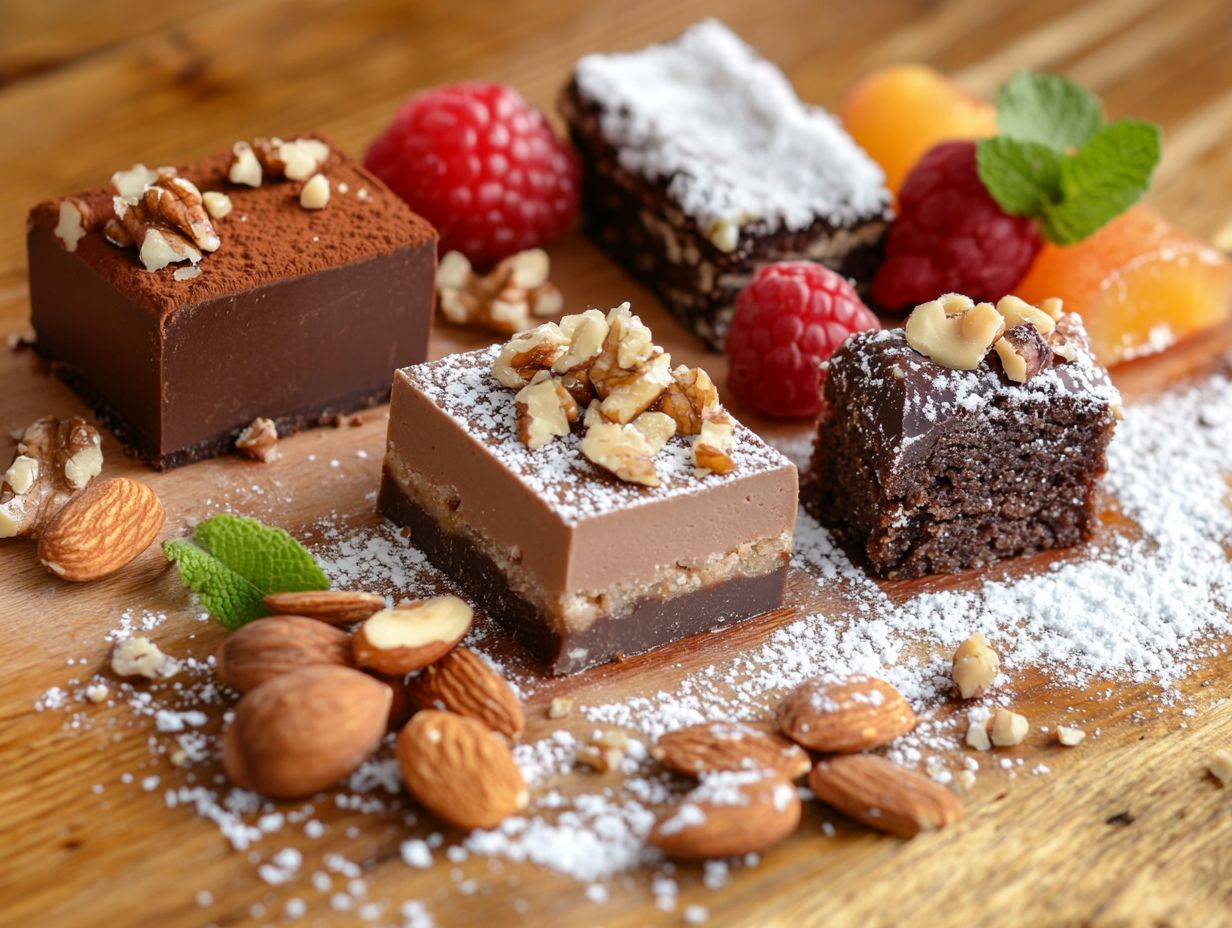
While raw desserts are often lauded for their numerous health benefits, addressing safety concerns is vital to enjoy every bite of your delicious raw dessert! For instance, a raw carrot cake with cream cheese frosting must be handled properly to avoid any health risks.
A solid grasp of proper food safety practices is essential when preparing and indulging in raw desserts. Certain ingredients can pose risks if not handled with care.
Frequently Asked Questions
What is the texture of raw desserts, including raw carrot cake?
The texture of raw desserts can vary, but it is typically smooth and creamy. It can also have a slightly chewy or dense texture, depending on the ingredients used.
How do raw desserts get their unique texture, like in a vanilla gelato?
The texture of raw desserts is achieved through the use of ingredients like nuts, dates, and coconut oil, which provide a creamy and rich base. Techniques like soaking and blending also contribute to the texture.
Can raw desserts be crunchy, like pralines?
While most raw desserts have a smooth texture, some may also have a crunchy component. This can be achieved by adding nuts, seeds, or cacao nibs to the mix.
Why is it important to understand the texture of raw desserts, including soft desserts?
Understanding the texture of raw desserts can help you create the perfect texture for your desired dessert. It also allows you to make substitutions or modifications to achieve the desired texture.
How can you adjust the texture of a raw dessert, particularly the tasty layers?
If you find that the texture of your raw dessert is too dense or thick, you can add more liquid, such as water or nut milk. If it is too runny, you can add more dry ingredients like nuts or coconut flour to thicken it.
What are some common texture variations in raw desserts, such as in a chocolate cheesecake?
Some common texture variations in raw desserts include smooth and creamy for cheesecakes or puddings, fudgy for brownies or truffles, and chewy for energy balls or bars.
Are you ready to try making your own raw desserts? Share your experiences and enjoy the delicious journey!

